Evaluating Leadership, Management, Culture, and Strategy at Tesco
VerifiedAdded on 2023/06/12
|10
|2560
|452
Essay
AI Summary
This essay provides an analysis of leadership and management within Tesco, a British multinational groceries and retailer brand. It distinguishes between leadership, which involves motivating and influencing employees, and management, which focuses on planning, organizing, directing, and controlling tasks. The report highlights Tesco's democratic leadership style and its effective communication strategies. It also examines factors influencing Tesco's organizational culture, such as leadership principles, the nature of the retail business, and recruitment practices. Furthermore, the essay discusses the purposes of Tesco's mission, vision, and value statements in guiding the organization's direction and fostering a positive work environment. The conclusion emphasizes the importance of both leadership and management in enhancing organizational performance and productivity.
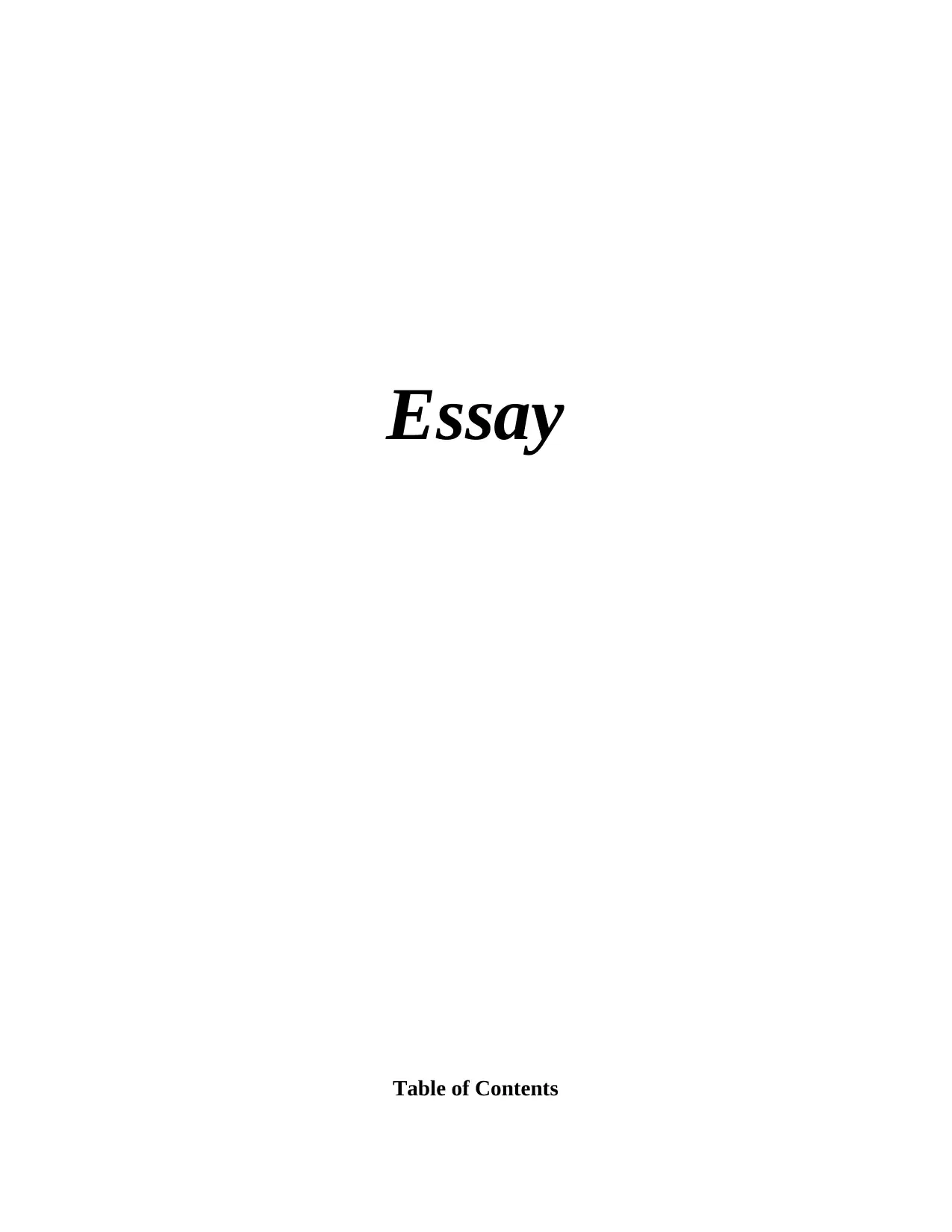
Essay
Table of Contents
Table of Contents
Paraphrase This Document
Need a fresh take? Get an instant paraphrase of this document with our AI Paraphraser
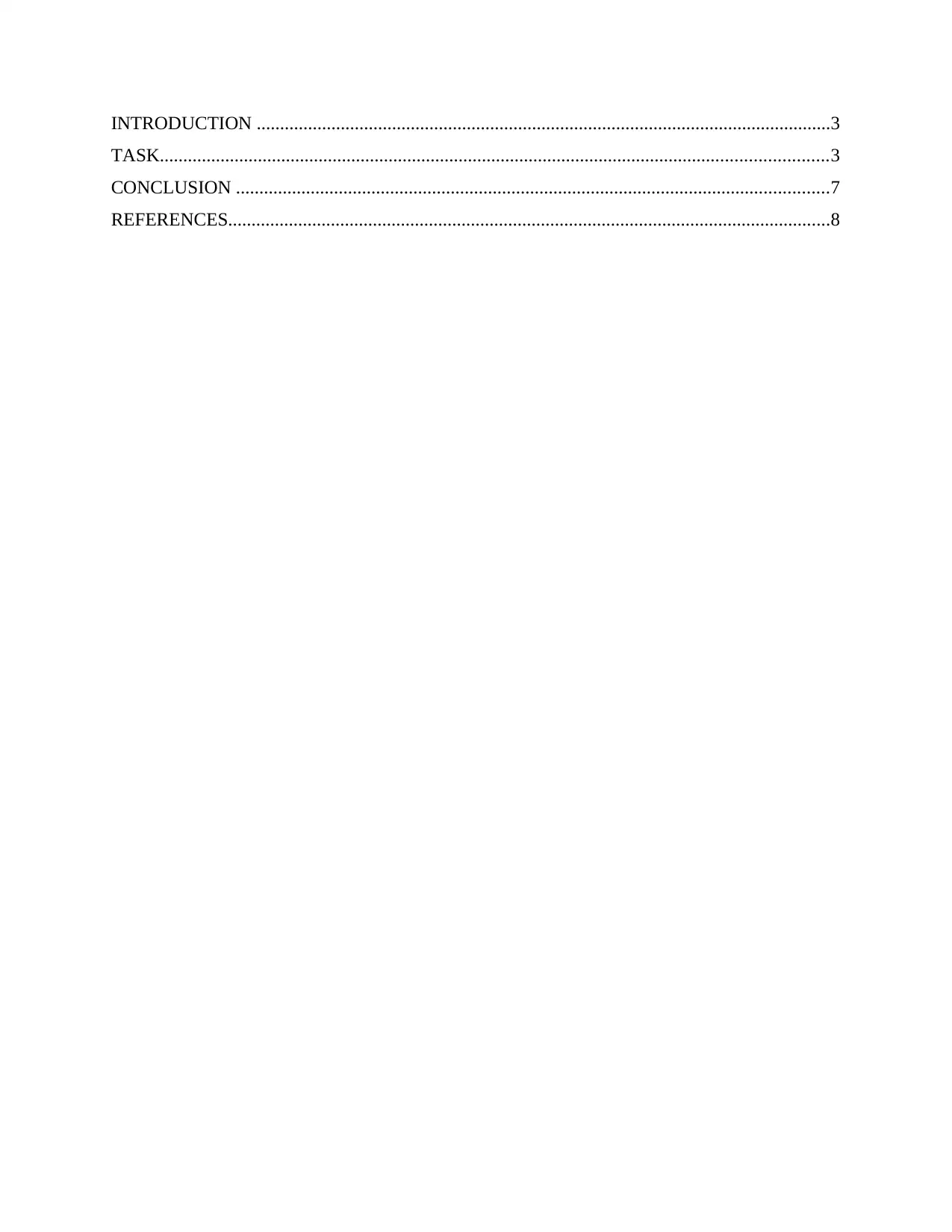
INTRODUCTION ...........................................................................................................................3
TASK...............................................................................................................................................3
CONCLUSION ...............................................................................................................................7
REFERENCES.................................................................................................................................8
TASK...............................................................................................................................................3
CONCLUSION ...............................................................................................................................7
REFERENCES.................................................................................................................................8
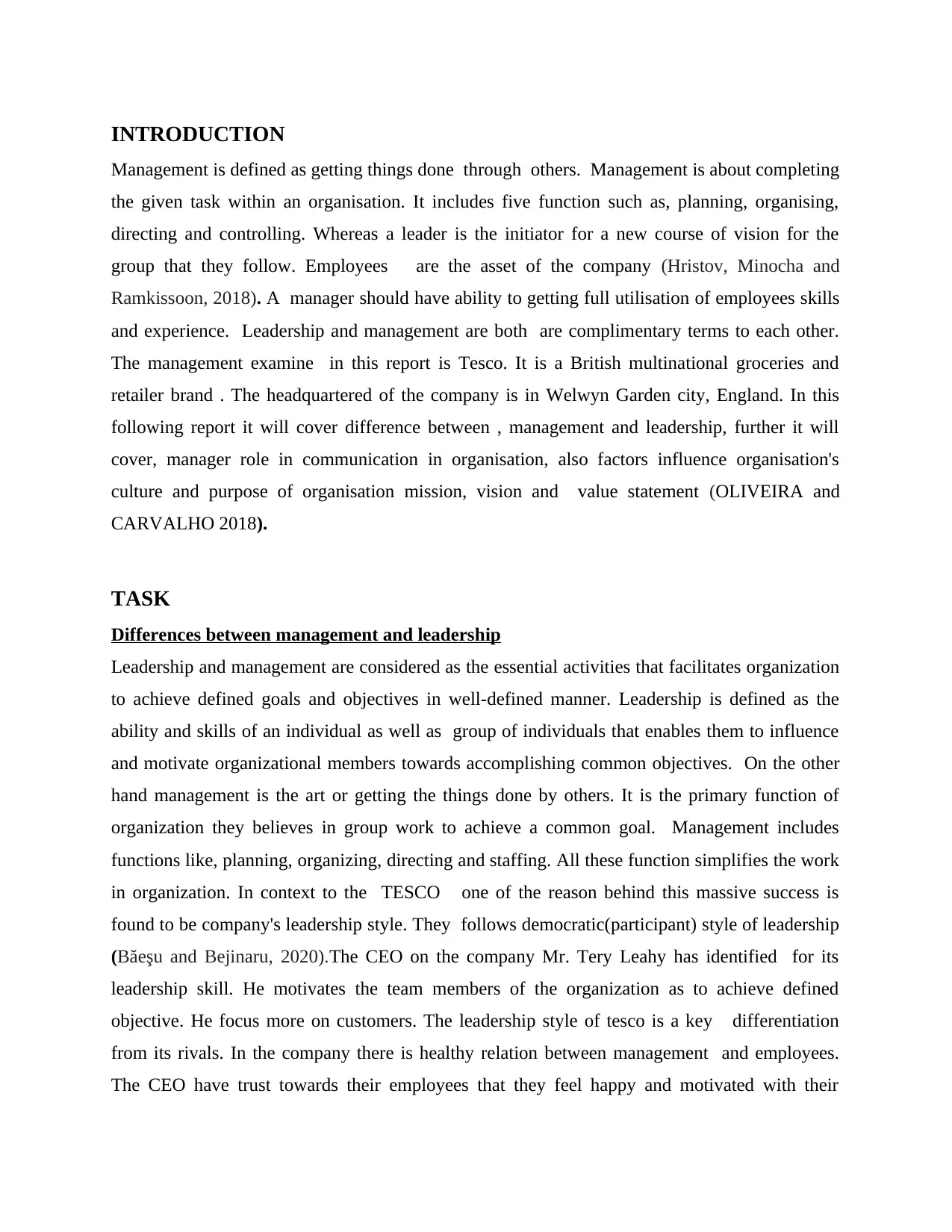
INTRODUCTION
Management is defined as getting things done through others. Management is about completing
the given task within an organisation. It includes five function such as, planning, organising,
directing and controlling. Whereas a leader is the initiator for a new course of vision for the
group that they follow. Employees are the asset of the company (Hristov, Minocha and
Ramkissoon, 2018). A manager should have ability to getting full utilisation of employees skills
and experience. Leadership and management are both are complimentary terms to each other.
The management examine in this report is Tesco. It is a British multinational groceries and
retailer brand . The headquartered of the company is in Welwyn Garden city, England. In this
following report it will cover difference between , management and leadership, further it will
cover, manager role in communication in organisation, also factors influence organisation's
culture and purpose of organisation mission, vision and value statement (OLIVEIRA and
CARVALHO 2018).
TASK
Differences between management and leadership
Leadership and management are considered as the essential activities that facilitates organization
to achieve defined goals and objectives in well-defined manner. Leadership is defined as the
ability and skills of an individual as well as group of individuals that enables them to influence
and motivate organizational members towards accomplishing common objectives. On the other
hand management is the art or getting the things done by others. It is the primary function of
organization they believes in group work to achieve a common goal. Management includes
functions like, planning, organizing, directing and staffing. All these function simplifies the work
in organization. In context to the TESCO one of the reason behind this massive success is
found to be company's leadership style. They follows democratic(participant) style of leadership
(Băeşu and Bejinaru, 2020).The CEO on the company Mr. Tery Leahy has identified for its
leadership skill. He motivates the team members of the organization as to achieve defined
objective. He focus more on customers. The leadership style of tesco is a key differentiation
from its rivals. In the company there is healthy relation between management and employees.
The CEO have trust towards their employees that they feel happy and motivated with their
Management is defined as getting things done through others. Management is about completing
the given task within an organisation. It includes five function such as, planning, organising,
directing and controlling. Whereas a leader is the initiator for a new course of vision for the
group that they follow. Employees are the asset of the company (Hristov, Minocha and
Ramkissoon, 2018). A manager should have ability to getting full utilisation of employees skills
and experience. Leadership and management are both are complimentary terms to each other.
The management examine in this report is Tesco. It is a British multinational groceries and
retailer brand . The headquartered of the company is in Welwyn Garden city, England. In this
following report it will cover difference between , management and leadership, further it will
cover, manager role in communication in organisation, also factors influence organisation's
culture and purpose of organisation mission, vision and value statement (OLIVEIRA and
CARVALHO 2018).
TASK
Differences between management and leadership
Leadership and management are considered as the essential activities that facilitates organization
to achieve defined goals and objectives in well-defined manner. Leadership is defined as the
ability and skills of an individual as well as group of individuals that enables them to influence
and motivate organizational members towards accomplishing common objectives. On the other
hand management is the art or getting the things done by others. It is the primary function of
organization they believes in group work to achieve a common goal. Management includes
functions like, planning, organizing, directing and staffing. All these function simplifies the work
in organization. In context to the TESCO one of the reason behind this massive success is
found to be company's leadership style. They follows democratic(participant) style of leadership
(Băeşu and Bejinaru, 2020).The CEO on the company Mr. Tery Leahy has identified for its
leadership skill. He motivates the team members of the organization as to achieve defined
objective. He focus more on customers. The leadership style of tesco is a key differentiation
from its rivals. In the company there is healthy relation between management and employees.
The CEO have trust towards their employees that they feel happy and motivated with their
⊘ This is a preview!⊘
Do you want full access?
Subscribe today to unlock all pages.

Trusted by 1+ million students worldwide
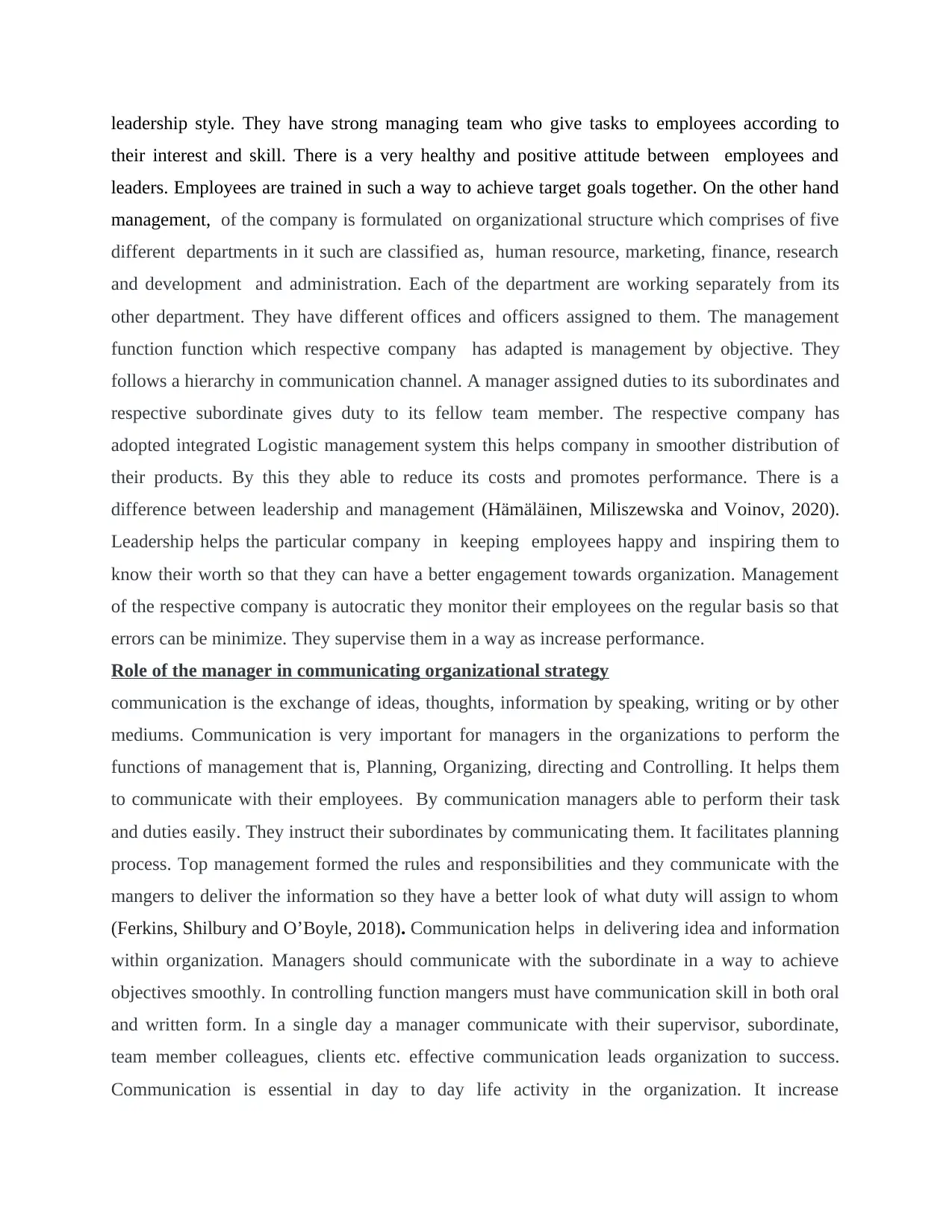
leadership style. They have strong managing team who give tasks to employees according to
their interest and skill. There is a very healthy and positive attitude between employees and
leaders. Employees are trained in such a way to achieve target goals together. On the other hand
management, of the company is formulated on organizational structure which comprises of five
different departments in it such are classified as, human resource, marketing, finance, research
and development and administration. Each of the department are working separately from its
other department. They have different offices and officers assigned to them. The management
function function which respective company has adapted is management by objective. They
follows a hierarchy in communication channel. A manager assigned duties to its subordinates and
respective subordinate gives duty to its fellow team member. The respective company has
adopted integrated Logistic management system this helps company in smoother distribution of
their products. By this they able to reduce its costs and promotes performance. There is a
difference between leadership and management (Hämäläinen, Miliszewska and Voinov, 2020).
Leadership helps the particular company in keeping employees happy and inspiring them to
know their worth so that they can have a better engagement towards organization. Management
of the respective company is autocratic they monitor their employees on the regular basis so that
errors can be minimize. They supervise them in a way as increase performance.
Role of the manager in communicating organizational strategy
communication is the exchange of ideas, thoughts, information by speaking, writing or by other
mediums. Communication is very important for managers in the organizations to perform the
functions of management that is, Planning, Organizing, directing and Controlling. It helps them
to communicate with their employees. By communication managers able to perform their task
and duties easily. They instruct their subordinates by communicating them. It facilitates planning
process. Top management formed the rules and responsibilities and they communicate with the
mangers to deliver the information so they have a better look of what duty will assign to whom
(Ferkins, Shilbury and O’Boyle, 2018). Communication helps in delivering idea and information
within organization. Managers should communicate with the subordinate in a way to achieve
objectives smoothly. In controlling function mangers must have communication skill in both oral
and written form. In a single day a manager communicate with their supervisor, subordinate,
team member colleagues, clients etc. effective communication leads organization to success.
Communication is essential in day to day life activity in the organization. It increase
their interest and skill. There is a very healthy and positive attitude between employees and
leaders. Employees are trained in such a way to achieve target goals together. On the other hand
management, of the company is formulated on organizational structure which comprises of five
different departments in it such are classified as, human resource, marketing, finance, research
and development and administration. Each of the department are working separately from its
other department. They have different offices and officers assigned to them. The management
function function which respective company has adapted is management by objective. They
follows a hierarchy in communication channel. A manager assigned duties to its subordinates and
respective subordinate gives duty to its fellow team member. The respective company has
adopted integrated Logistic management system this helps company in smoother distribution of
their products. By this they able to reduce its costs and promotes performance. There is a
difference between leadership and management (Hämäläinen, Miliszewska and Voinov, 2020).
Leadership helps the particular company in keeping employees happy and inspiring them to
know their worth so that they can have a better engagement towards organization. Management
of the respective company is autocratic they monitor their employees on the regular basis so that
errors can be minimize. They supervise them in a way as increase performance.
Role of the manager in communicating organizational strategy
communication is the exchange of ideas, thoughts, information by speaking, writing or by other
mediums. Communication is very important for managers in the organizations to perform the
functions of management that is, Planning, Organizing, directing and Controlling. It helps them
to communicate with their employees. By communication managers able to perform their task
and duties easily. They instruct their subordinates by communicating them. It facilitates planning
process. Top management formed the rules and responsibilities and they communicate with the
mangers to deliver the information so they have a better look of what duty will assign to whom
(Ferkins, Shilbury and O’Boyle, 2018). Communication helps in delivering idea and information
within organization. Managers should communicate with the subordinate in a way to achieve
objectives smoothly. In controlling function mangers must have communication skill in both oral
and written form. In a single day a manager communicate with their supervisor, subordinate,
team member colleagues, clients etc. effective communication leads organization to success.
Communication is essential in day to day life activity in the organization. It increase
Paraphrase This Document
Need a fresh take? Get an instant paraphrase of this document with our AI Paraphraser
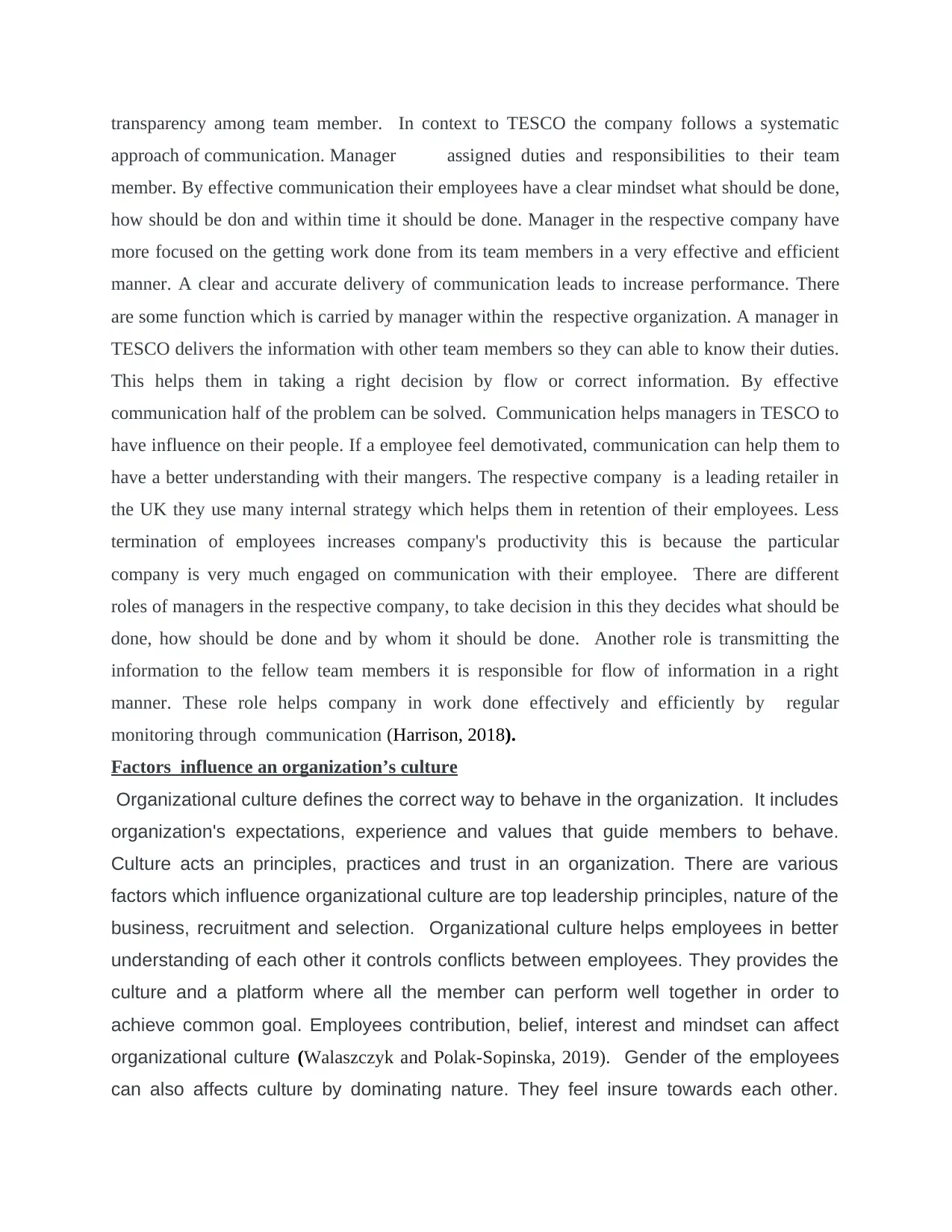
transparency among team member. In context to TESCO the company follows a systematic
approach of communication. Manager assigned duties and responsibilities to their team
member. By effective communication their employees have a clear mindset what should be done,
how should be don and within time it should be done. Manager in the respective company have
more focused on the getting work done from its team members in a very effective and efficient
manner. A clear and accurate delivery of communication leads to increase performance. There
are some function which is carried by manager within the respective organization. A manager in
TESCO delivers the information with other team members so they can able to know their duties.
This helps them in taking a right decision by flow or correct information. By effective
communication half of the problem can be solved. Communication helps managers in TESCO to
have influence on their people. If a employee feel demotivated, communication can help them to
have a better understanding with their mangers. The respective company is a leading retailer in
the UK they use many internal strategy which helps them in retention of their employees. Less
termination of employees increases company's productivity this is because the particular
company is very much engaged on communication with their employee. There are different
roles of managers in the respective company, to take decision in this they decides what should be
done, how should be done and by whom it should be done. Another role is transmitting the
information to the fellow team members it is responsible for flow of information in a right
manner. These role helps company in work done effectively and efficiently by regular
monitoring through communication (Harrison, 2018).
Factors influence an organization’s culture
Organizational culture defines the correct way to behave in the organization. It includes
organization's expectations, experience and values that guide members to behave.
Culture acts an principles, practices and trust in an organization. There are various
factors which influence organizational culture are top leadership principles, nature of the
business, recruitment and selection. Organizational culture helps employees in better
understanding of each other it controls conflicts between employees. They provides the
culture and a platform where all the member can perform well together in order to
achieve common goal. Employees contribution, belief, interest and mindset can affect
organizational culture (Walaszczyk and Polak-Sopinska, 2019). Gender of the employees
can also affects culture by dominating nature. They feel insure towards each other.
approach of communication. Manager assigned duties and responsibilities to their team
member. By effective communication their employees have a clear mindset what should be done,
how should be don and within time it should be done. Manager in the respective company have
more focused on the getting work done from its team members in a very effective and efficient
manner. A clear and accurate delivery of communication leads to increase performance. There
are some function which is carried by manager within the respective organization. A manager in
TESCO delivers the information with other team members so they can able to know their duties.
This helps them in taking a right decision by flow or correct information. By effective
communication half of the problem can be solved. Communication helps managers in TESCO to
have influence on their people. If a employee feel demotivated, communication can help them to
have a better understanding with their mangers. The respective company is a leading retailer in
the UK they use many internal strategy which helps them in retention of their employees. Less
termination of employees increases company's productivity this is because the particular
company is very much engaged on communication with their employee. There are different
roles of managers in the respective company, to take decision in this they decides what should be
done, how should be done and by whom it should be done. Another role is transmitting the
information to the fellow team members it is responsible for flow of information in a right
manner. These role helps company in work done effectively and efficiently by regular
monitoring through communication (Harrison, 2018).
Factors influence an organization’s culture
Organizational culture defines the correct way to behave in the organization. It includes
organization's expectations, experience and values that guide members to behave.
Culture acts an principles, practices and trust in an organization. There are various
factors which influence organizational culture are top leadership principles, nature of the
business, recruitment and selection. Organizational culture helps employees in better
understanding of each other it controls conflicts between employees. They provides the
culture and a platform where all the member can perform well together in order to
achieve common goal. Employees contribution, belief, interest and mindset can affect
organizational culture (Walaszczyk and Polak-Sopinska, 2019). Gender of the employees
can also affects culture by dominating nature. They feel insure towards each other.
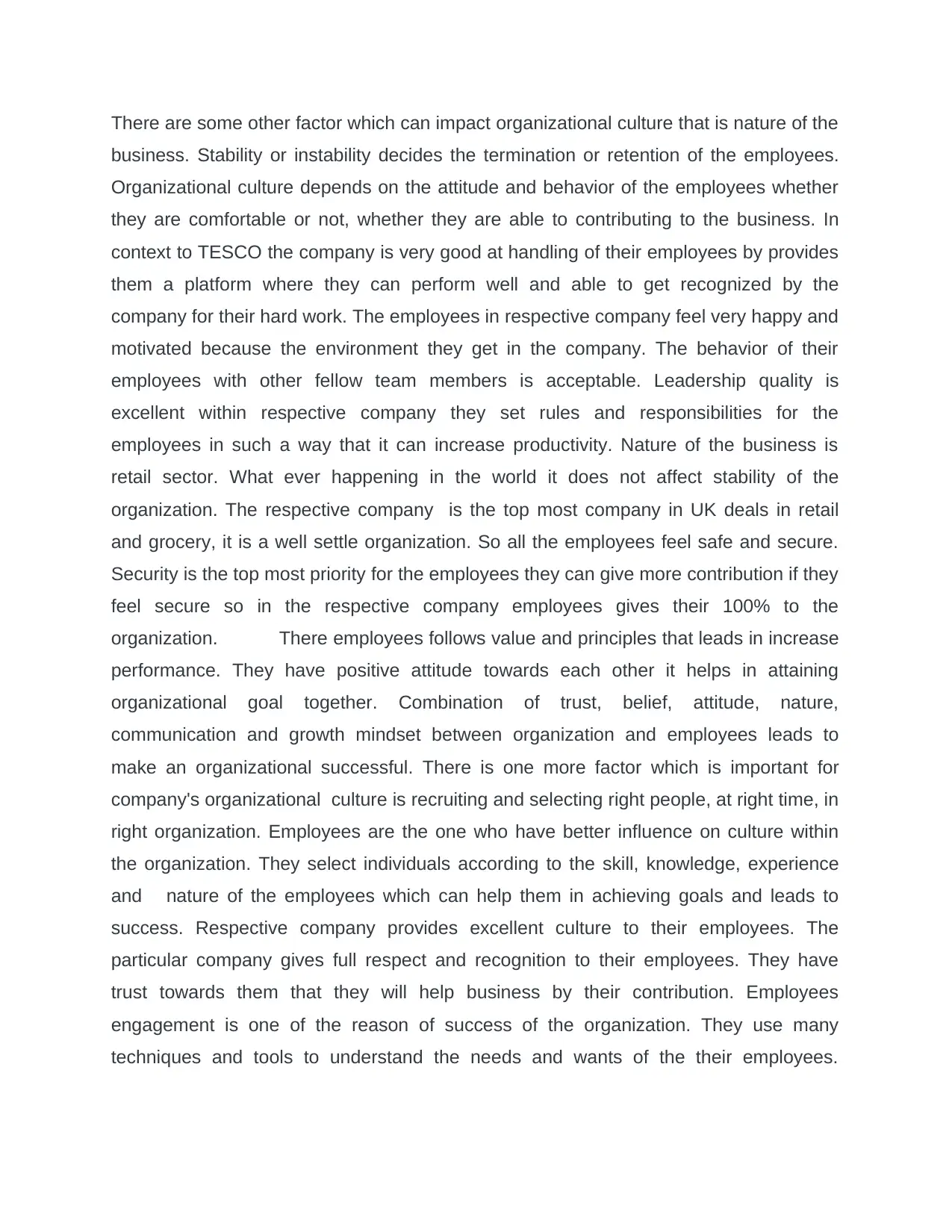
There are some other factor which can impact organizational culture that is nature of the
business. Stability or instability decides the termination or retention of the employees.
Organizational culture depends on the attitude and behavior of the employees whether
they are comfortable or not, whether they are able to contributing to the business. In
context to TESCO the company is very good at handling of their employees by provides
them a platform where they can perform well and able to get recognized by the
company for their hard work. The employees in respective company feel very happy and
motivated because the environment they get in the company. The behavior of their
employees with other fellow team members is acceptable. Leadership quality is
excellent within respective company they set rules and responsibilities for the
employees in such a way that it can increase productivity. Nature of the business is
retail sector. What ever happening in the world it does not affect stability of the
organization. The respective company is the top most company in UK deals in retail
and grocery, it is a well settle organization. So all the employees feel safe and secure.
Security is the top most priority for the employees they can give more contribution if they
feel secure so in the respective company employees gives their 100% to the
organization. There employees follows value and principles that leads in increase
performance. They have positive attitude towards each other it helps in attaining
organizational goal together. Combination of trust, belief, attitude, nature,
communication and growth mindset between organization and employees leads to
make an organizational successful. There is one more factor which is important for
company's organizational culture is recruiting and selecting right people, at right time, in
right organization. Employees are the one who have better influence on culture within
the organization. They select individuals according to the skill, knowledge, experience
and nature of the employees which can help them in achieving goals and leads to
success. Respective company provides excellent culture to their employees. The
particular company gives full respect and recognition to their employees. They have
trust towards them that they will help business by their contribution. Employees
engagement is one of the reason of success of the organization. They use many
techniques and tools to understand the needs and wants of the their employees.
business. Stability or instability decides the termination or retention of the employees.
Organizational culture depends on the attitude and behavior of the employees whether
they are comfortable or not, whether they are able to contributing to the business. In
context to TESCO the company is very good at handling of their employees by provides
them a platform where they can perform well and able to get recognized by the
company for their hard work. The employees in respective company feel very happy and
motivated because the environment they get in the company. The behavior of their
employees with other fellow team members is acceptable. Leadership quality is
excellent within respective company they set rules and responsibilities for the
employees in such a way that it can increase productivity. Nature of the business is
retail sector. What ever happening in the world it does not affect stability of the
organization. The respective company is the top most company in UK deals in retail
and grocery, it is a well settle organization. So all the employees feel safe and secure.
Security is the top most priority for the employees they can give more contribution if they
feel secure so in the respective company employees gives their 100% to the
organization. There employees follows value and principles that leads in increase
performance. They have positive attitude towards each other it helps in attaining
organizational goal together. Combination of trust, belief, attitude, nature,
communication and growth mindset between organization and employees leads to
make an organizational successful. There is one more factor which is important for
company's organizational culture is recruiting and selecting right people, at right time, in
right organization. Employees are the one who have better influence on culture within
the organization. They select individuals according to the skill, knowledge, experience
and nature of the employees which can help them in achieving goals and leads to
success. Respective company provides excellent culture to their employees. The
particular company gives full respect and recognition to their employees. They have
trust towards them that they will help business by their contribution. Employees
engagement is one of the reason of success of the organization. They use many
techniques and tools to understand the needs and wants of the their employees.
⊘ This is a preview!⊘
Do you want full access?
Subscribe today to unlock all pages.

Trusted by 1+ million students worldwide
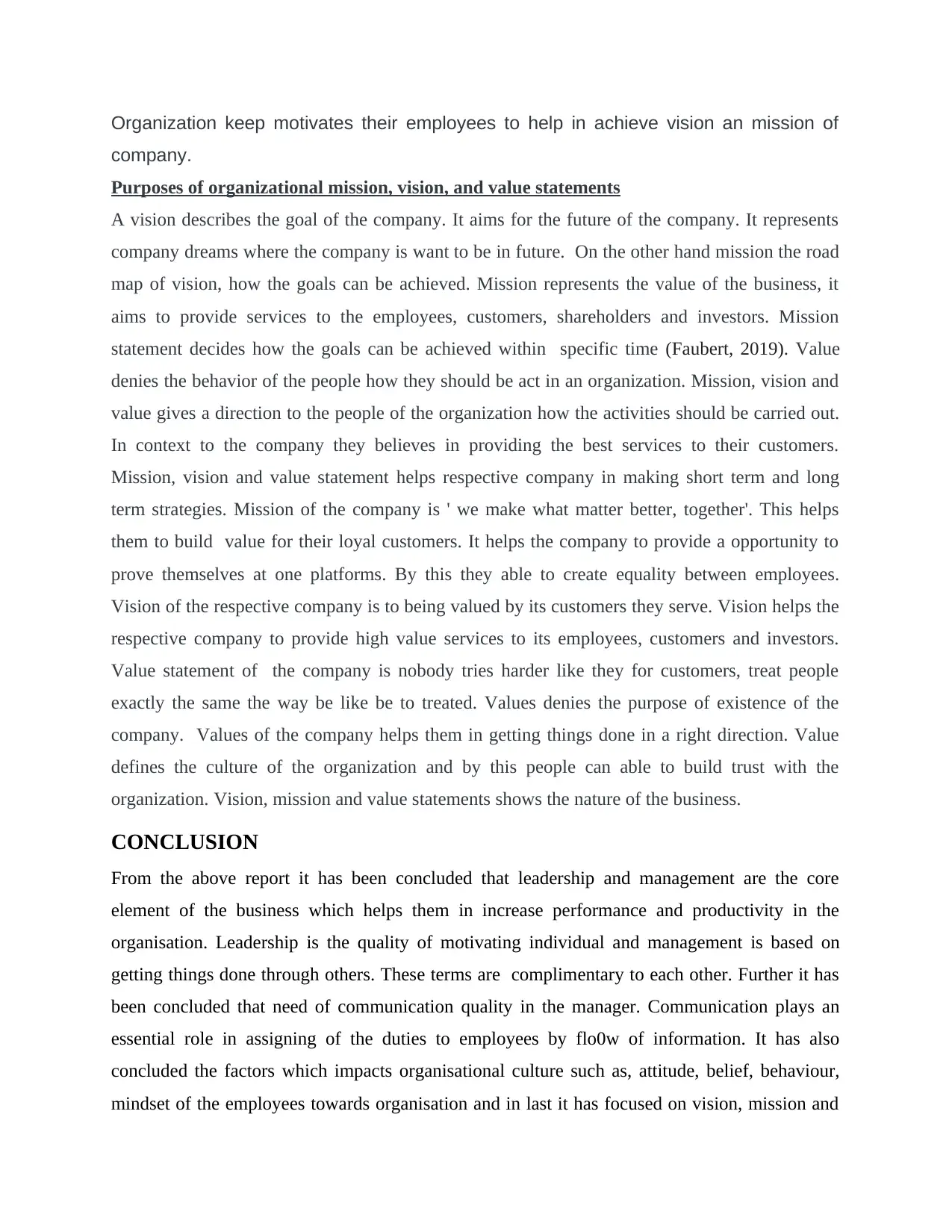
Organization keep motivates their employees to help in achieve vision an mission of
company.
Purposes of organizational mission, vision, and value statements
A vision describes the goal of the company. It aims for the future of the company. It represents
company dreams where the company is want to be in future. On the other hand mission the road
map of vision, how the goals can be achieved. Mission represents the value of the business, it
aims to provide services to the employees, customers, shareholders and investors. Mission
statement decides how the goals can be achieved within specific time (Faubert, 2019). Value
denies the behavior of the people how they should be act in an organization. Mission, vision and
value gives a direction to the people of the organization how the activities should be carried out.
In context to the company they believes in providing the best services to their customers.
Mission, vision and value statement helps respective company in making short term and long
term strategies. Mission of the company is ' we make what matter better, together'. This helps
them to build value for their loyal customers. It helps the company to provide a opportunity to
prove themselves at one platforms. By this they able to create equality between employees.
Vision of the respective company is to being valued by its customers they serve. Vision helps the
respective company to provide high value services to its employees, customers and investors.
Value statement of the company is nobody tries harder like they for customers, treat people
exactly the same the way be like be to treated. Values denies the purpose of existence of the
company. Values of the company helps them in getting things done in a right direction. Value
defines the culture of the organization and by this people can able to build trust with the
organization. Vision, mission and value statements shows the nature of the business.
CONCLUSION
From the above report it has been concluded that leadership and management are the core
element of the business which helps them in increase performance and productivity in the
organisation. Leadership is the quality of motivating individual and management is based on
getting things done through others. These terms are complimentary to each other. Further it has
been concluded that need of communication quality in the manager. Communication plays an
essential role in assigning of the duties to employees by flo0w of information. It has also
concluded the factors which impacts organisational culture such as, attitude, belief, behaviour,
mindset of the employees towards organisation and in last it has focused on vision, mission and
company.
Purposes of organizational mission, vision, and value statements
A vision describes the goal of the company. It aims for the future of the company. It represents
company dreams where the company is want to be in future. On the other hand mission the road
map of vision, how the goals can be achieved. Mission represents the value of the business, it
aims to provide services to the employees, customers, shareholders and investors. Mission
statement decides how the goals can be achieved within specific time (Faubert, 2019). Value
denies the behavior of the people how they should be act in an organization. Mission, vision and
value gives a direction to the people of the organization how the activities should be carried out.
In context to the company they believes in providing the best services to their customers.
Mission, vision and value statement helps respective company in making short term and long
term strategies. Mission of the company is ' we make what matter better, together'. This helps
them to build value for their loyal customers. It helps the company to provide a opportunity to
prove themselves at one platforms. By this they able to create equality between employees.
Vision of the respective company is to being valued by its customers they serve. Vision helps the
respective company to provide high value services to its employees, customers and investors.
Value statement of the company is nobody tries harder like they for customers, treat people
exactly the same the way be like be to treated. Values denies the purpose of existence of the
company. Values of the company helps them in getting things done in a right direction. Value
defines the culture of the organization and by this people can able to build trust with the
organization. Vision, mission and value statements shows the nature of the business.
CONCLUSION
From the above report it has been concluded that leadership and management are the core
element of the business which helps them in increase performance and productivity in the
organisation. Leadership is the quality of motivating individual and management is based on
getting things done through others. These terms are complimentary to each other. Further it has
been concluded that need of communication quality in the manager. Communication plays an
essential role in assigning of the duties to employees by flo0w of information. It has also
concluded the factors which impacts organisational culture such as, attitude, belief, behaviour,
mindset of the employees towards organisation and in last it has focused on vision, mission and
Paraphrase This Document
Need a fresh take? Get an instant paraphrase of this document with our AI Paraphraser
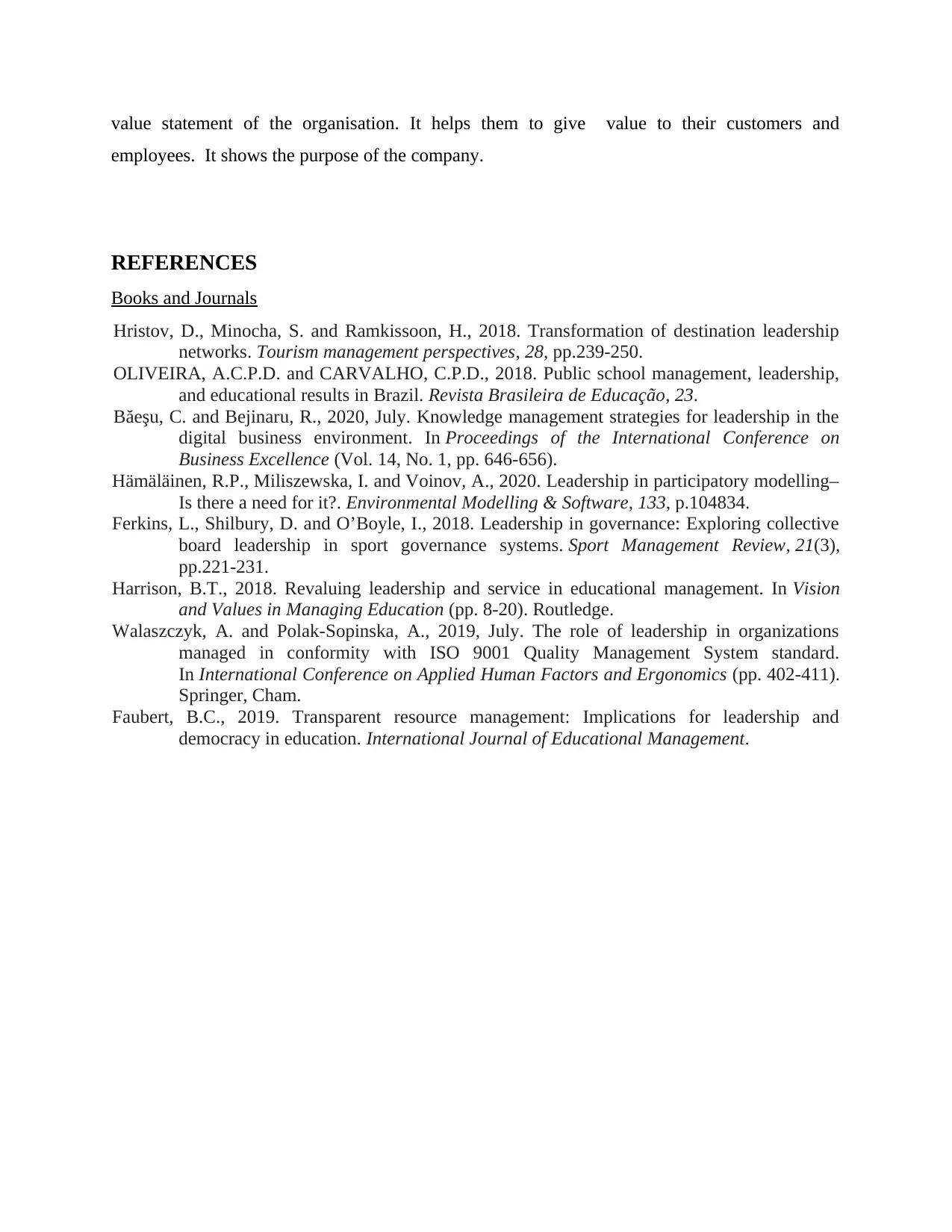
value statement of the organisation. It helps them to give value to their customers and
employees. It shows the purpose of the company.
REFERENCES
Books and Journals
Hristov, D., Minocha, S. and Ramkissoon, H., 2018. Transformation of destination leadership
networks. Tourism management perspectives, 28, pp.239-250.
OLIVEIRA, A.C.P.D. and CARVALHO, C.P.D., 2018. Public school management, leadership,
and educational results in Brazil. Revista Brasileira de Educação, 23.
Băeşu, C. and Bejinaru, R., 2020, July. Knowledge management strategies for leadership in the
digital business environment. In Proceedings of the International Conference on
Business Excellence (Vol. 14, No. 1, pp. 646-656).
Hämäläinen, R.P., Miliszewska, I. and Voinov, A., 2020. Leadership in participatory modelling–
Is there a need for it?. Environmental Modelling & Software, 133, p.104834.
Ferkins, L., Shilbury, D. and O’Boyle, I., 2018. Leadership in governance: Exploring collective
board leadership in sport governance systems. Sport Management Review, 21(3),
pp.221-231.
Harrison, B.T., 2018. Revaluing leadership and service in educational management. In Vision
and Values in Managing Education (pp. 8-20). Routledge.
Walaszczyk, A. and Polak-Sopinska, A., 2019, July. The role of leadership in organizations
managed in conformity with ISO 9001 Quality Management System standard.
In International Conference on Applied Human Factors and Ergonomics (pp. 402-411).
Springer, Cham.
Faubert, B.C., 2019. Transparent resource management: Implications for leadership and
democracy in education. International Journal of Educational Management.
employees. It shows the purpose of the company.
REFERENCES
Books and Journals
Hristov, D., Minocha, S. and Ramkissoon, H., 2018. Transformation of destination leadership
networks. Tourism management perspectives, 28, pp.239-250.
OLIVEIRA, A.C.P.D. and CARVALHO, C.P.D., 2018. Public school management, leadership,
and educational results in Brazil. Revista Brasileira de Educação, 23.
Băeşu, C. and Bejinaru, R., 2020, July. Knowledge management strategies for leadership in the
digital business environment. In Proceedings of the International Conference on
Business Excellence (Vol. 14, No. 1, pp. 646-656).
Hämäläinen, R.P., Miliszewska, I. and Voinov, A., 2020. Leadership in participatory modelling–
Is there a need for it?. Environmental Modelling & Software, 133, p.104834.
Ferkins, L., Shilbury, D. and O’Boyle, I., 2018. Leadership in governance: Exploring collective
board leadership in sport governance systems. Sport Management Review, 21(3),
pp.221-231.
Harrison, B.T., 2018. Revaluing leadership and service in educational management. In Vision
and Values in Managing Education (pp. 8-20). Routledge.
Walaszczyk, A. and Polak-Sopinska, A., 2019, July. The role of leadership in organizations
managed in conformity with ISO 9001 Quality Management System standard.
In International Conference on Applied Human Factors and Ergonomics (pp. 402-411).
Springer, Cham.
Faubert, B.C., 2019. Transparent resource management: Implications for leadership and
democracy in education. International Journal of Educational Management.

⊘ This is a preview!⊘
Do you want full access?
Subscribe today to unlock all pages.

Trusted by 1+ million students worldwide

1 out of 10
Related Documents
Your All-in-One AI-Powered Toolkit for Academic Success.
+13062052269
info@desklib.com
Available 24*7 on WhatsApp / Email
![[object Object]](/_next/static/media/star-bottom.7253800d.svg)
Unlock your academic potential
Copyright © 2020–2025 A2Z Services. All Rights Reserved. Developed and managed by ZUCOL.





